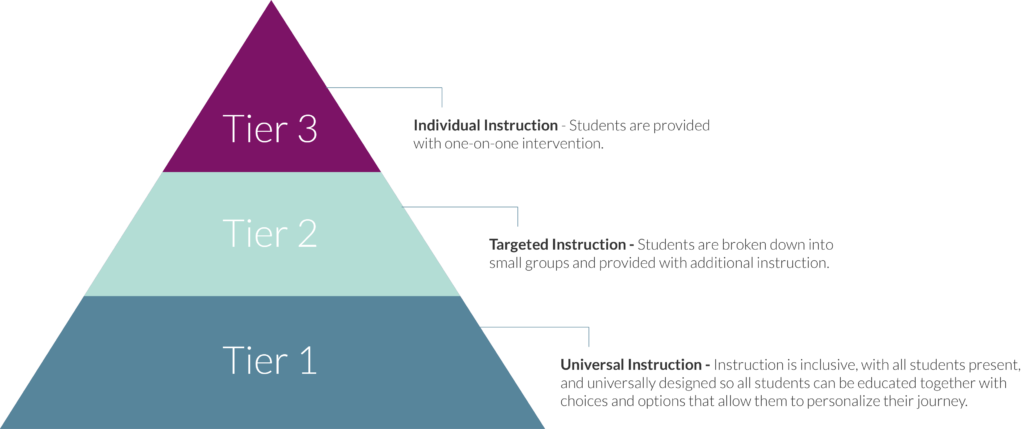Like all industries, the education industry loves alphabet soup. We could list acronyms for days, but there are two that are drawing our attention today: MTSS and RTI.
MTSS stands for multi-tiered system of support. RTI is response to intervention. Oftentimes, educators use these terms interchangeably but there are some distinct and important differences.
RTI is a multi-tiered approach focused on providing direct services, supports, and interventions for at-risk students. You’ll often see the concept of RTI displayed in a visual pyramid, like the below:

RTI is built on the belief that all students are Tier 1 students first and should receive universal instruction with all students present. Some students will require additional intervention. Those students, when RTI is executed properly, continue to receive high-quality Tier 1 instruction, but may also require targeted support through Tier 2 instruction in certain areas. When intensive support is required, students may receive Tier 3 instruction, but they also continue to receive universal instruction under Tier 1.
The tiers are fluid; a student isn’t a “Tier 2 student” or a “Tier 3 student.” Additional support isn’t a life sentence. While students require targeted or intensive support, they get it. When their needs have been met, additional support can be discontinued.
One of the biggest shortcomings of RTI is that educators and systems often supplant high-quality Tier 1 instruction with Tier 2 or Tier 3 instruction. RTI also has a particular focus on the academic needs of the student and often times fails to consider the whole child or the systematic barriers that prevent this model from being successful.
MTSS is a distinct approach that builds upon the original concept of tiered support, as with RTI, but is more pro-active. MTSS, unlike RTI, addresses systematic barriers and conditions for both students and educators.
We had the pleasure of working with the Massachusetts Department of Elementary and Secondary Education on rewriting the Massachusetts MTSS Blueprint. We wanted to honor the three-tiered approach, but emphasize that we should be providing tiered support, not only from an academic perspective but also on a behavioral and social-emotional level to promote equitable access. We encourage districts, schools, and educators to use Universal Design for Learning (UDL) as a framework for fostering equitable access and effectively executing the tiered approach in an inclusive environment.
Since MTSS must address systematic barriers that prevent students from learning, we needed to take a deep dive into the factors that can lead to both educator and student failure or success. Three categories of system drivers can have an impact on the effectiveness of a tiered system.
- Leadership drivers which include shared responsibility and collaboration, resource allocation and consideration for funding and scheduling, student and family engagement, and using a scientifically-based planning model.
- Competency Drivers consider staff recruitment and retention, professional development, and educator feedback and evaluation.
- Implementation Drivers that encourage administrators to use evidence-based practices, implementation fidelity, data-based decision making, and standards-based curriculum, instruction, and assessment.
Altogether, we came up with the below visual demonstrating each of these components working together to build a multi-tiered system of support.
2019, Massachusetts Multi-Tiered System of Support Visual, Massachusetts Department of Elementary and Secondary Education, Novak Educational Consulting, RECA
When all drivers are working in place together, we can create a system of support that allows both students and educators to be successful.
If you need assistance with implementing a multi-tiered system of support, we can provide some guidance. Learn more about our professional development and long-term implementation assistance programs here.
